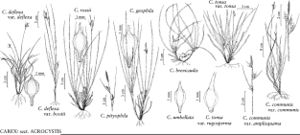familyCyperaceae
genusCarex
sectionCarex sect. Acrocystis
speciesCarex deflexa
varietyCarex deflexa var. deflexa
Difference between revisions of "Carex deflexa var. deflexa"
Common names: Carex déprimé
Synonyms: Carex deflexa var. deanii unknown
FNA>Volume Importer |
FNA>Volume Importer |
||
| Line 23: | Line 23: | ||
|elevation=20–1700 m | |elevation=20–1700 m | ||
|distribution=Greenland;St. Pierre and Miquelon;Alta.;B.C.;Man.;N.B.;Nfld. and Labr.;N.W.T.;N.S.;Ont.;Que.;Sask.;Yukon;Alaska;Conn.;Maine;Mass.;Mich.;N.H.;N.Y.;Vt.;W.Va.;Wis. | |distribution=Greenland;St. Pierre and Miquelon;Alta.;B.C.;Man.;N.B.;Nfld. and Labr.;N.W.T.;N.S.;Ont.;Que.;Sask.;Yukon;Alaska;Conn.;Maine;Mass.;Mich.;N.H.;N.Y.;Vt.;W.Va.;Wis. | ||
| − | |discussion=<p>Plants recently discovered in the southern Appalachian Mountains (Georgia, North Carolina, and Virginia) have staminate spikes similar to those of Carex deflexa var. boottii, averaging larger than those of var. deflexa. They also tend to produce basal spikes more consistently than do the northern plants.</p> | + | |discussion=<p>Plants recently discovered in the southern Appalachian Mountains (Georgia, North Carolina, and Virginia) have staminate spikes similar to those of <i>Carex deflexa </i>var.<i> boottii</i>, averaging larger than those of <i></i>var.<i> deflexa</i>. They also tend to produce basal spikes more consistently than do the northern plants.</p> |
|tables= | |tables= | ||
|references= | |references= | ||
| Line 47: | Line 47: | ||
|publication year= | |publication year= | ||
|special status= | |special status= | ||
| − | |source xml=https://jpend@bitbucket.org/aafc-mbb/fna-data-curation.git/src/ | + | |source xml=https://jpend@bitbucket.org/aafc-mbb/fna-data-curation.git/src/8f726806613d60c220dc4493de13607dd3150896/coarse_grained_fna_xml/V23/V23_1004.xml |
|genus=Carex | |genus=Carex | ||
|section=Carex sect. Acrocystis | |section=Carex sect. Acrocystis | ||
Revision as of 16:04, 18 September 2019
Culms usually smooth or weakly scabrous distally. staminate spikes 3.1–5.7 × 0.7–1.1 mm. 2n = 20–24, 30, 36.
Phenology: Fruiting mid May–late Aug.
Habitat: Moist to dry, open or shaded, mixed and coniferous woodlands, talus slopes, ridges, rock outcrops, burns, clearings, fields, banks, snowbeds
Elevation: 20–1700 m
Distribution

Greenland, St. Pierre and Miquelon, Alta., B.C., Man., N.B., Nfld. and Labr., N.W.T., N.S., Ont., Que., Sask., Yukon, Alaska, Conn., Maine, Mass., Mich., N.H., N.Y., Vt., W.Va., Wis.
Discussion
Plants recently discovered in the southern Appalachian Mountains (Georgia, North Carolina, and Virginia) have staminate spikes similar to those of Carex deflexa var. boottii, averaging larger than those of var. deflexa. They also tend to produce basal spikes more consistently than do the northern plants.
Selected References
None.
Lower Taxa
None.
